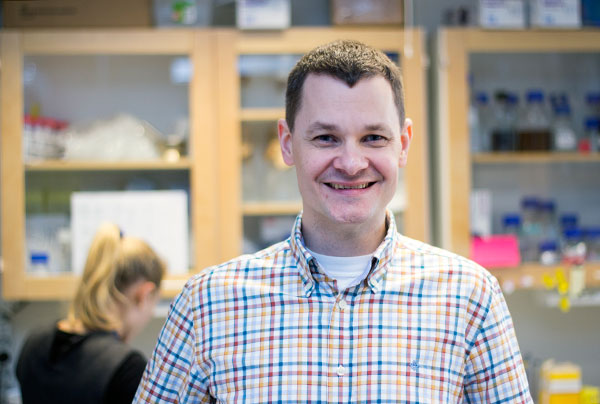Possible New Combination Treatment for Cancer

Jonas Nilsson, Sahlgrenska Cancer Center at the University of Gothenburg
A few years ago, a molecule known as “JQ1” was developed, which can block so called BET bromodomain proteins. This switch off the known cancer gene MYC thereby preventing cancer cells from dividing.
The discovery was regarded as a major breakthrough. A problem was that JQ1 did not function optimally in animal experiments, and this means that it has not been possible to test the treatment on cancer patients.
New molecule
Jonas Nilsson and his research group have developed, in collaboration with the Canadian company Zenith epigenetics, a new molecule known as “RVX2135”, which has been tested in mice with MYC-driven lymphoma. The study will be published this week in the early edition of the prestigious scientific journal PNAS and shows that the new molecule not only causes cancer cells in culture to stop growing, it also causes tumors to die. This means that the mice survive their cancer longer.
“We hypothesized that the new molecule could also switch off the MYC gene. However, our studies show that neither the JQ1 molecule nor the RVX2135 molecule have this property in these types of cells. This means that the mode of action is probably not as simple as we believed,” says Jonas Nilsson, Group Leader at the Sahlgrenska Cancer Center.
Increased survival in mice
The scientists in Gothenburg also discovered that the RVX2135 molecule activates the same genes as those activated by molecules known as “HDAC inhibitors”, which are already used to treat cancer. The scientists then tested HDAC inhibitors together with the newly discovered molecules and it turned out that the combination increased survival in mice with lymphoma.
“It was also possible to reduce the dose of HDAC inhibitors when used in combination with RVX2135 and this reduced adverse effects. We see this as a breakthrough in the clinical development of this type of treatment,” Jonas Nilsson explains.
Further development
Jonas Nilsson has recently founded the Sahlgrenska Translational Melanoma Group together with surgeons and oncologists at the Sahlgrenska University Hospital. This group will investigate whether the treatment can be used also for malignant melanoma.
“The work is challenging, but we believe that the prospects for success with combination treatments are good,” says Jonas Nilsson.
The article BET and HDAC inhibitors induce similar genes and biological effects and synergize to kill in Myc-induced murine lymphoma will be published online in Proceedings of the National Academy of Sciences on 16 June.
Link to article: http://www.pnas.org/content/early/2014/06/13/1406722111.abstract
More information about the research project: http://www.cancercenter.gu.se/research/nilsson-lab/
Contact:
Jonas Nilsson, Sahlgrenska Cancer Center at the Sahlgrenska Academy, University of Gothenburg
jonas.a.nilsson@surgery.gu.se
Tel.: +46 31 786 6768
Cell: +46 73 027 3039
http://sahlgrenska.gu.se/english/news_and_events/news/News_Detail/?languageId=10…
Media Contact
All latest news from the category: Health and Medicine
This subject area encompasses research and studies in the field of human medicine.
Among the wide-ranging list of topics covered here are anesthesiology, anatomy, surgery, human genetics, hygiene and environmental medicine, internal medicine, neurology, pharmacology, physiology, urology and dental medicine.
Newest articles

High-energy-density aqueous battery based on halogen multi-electron transfer
Traditional non-aqueous lithium-ion batteries have a high energy density, but their safety is compromised due to the flammable organic electrolytes they utilize. Aqueous batteries use water as the solvent for…

First-ever combined heart pump and pig kidney transplant
…gives new hope to patient with terminal illness. Surgeons at NYU Langone Health performed the first-ever combined mechanical heart pump and gene-edited pig kidney transplant surgery in a 54-year-old woman…

Biophysics: Testing how well biomarkers work
LMU researchers have developed a method to determine how reliably target proteins can be labeled using super-resolution fluorescence microscopy. Modern microscopy techniques make it possible to examine the inner workings…





















